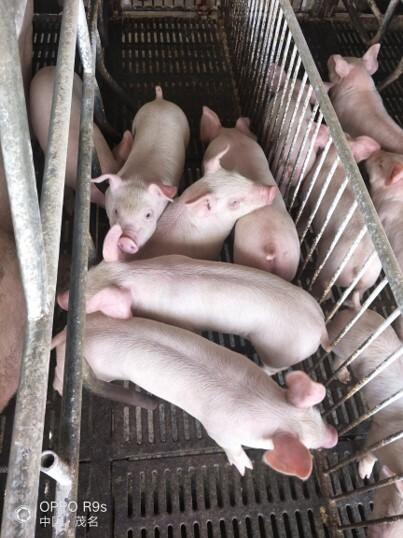Explore all the information on
Piglets nutrition
At weaning, piglets are challenged by multiple sudden changes in their environment and diet. They are typically weaned between 3 to 4 weeks, when their digestive tract and immune system are still in development. As they need to adapt to new components in the diet, they are challenged with lower feed intake, digestive disorders and nutrient losses. To ensure optimal growth, piglets need (pre)starter diets formulated to meet their nutritional requirements and fully support their digestive health and immune system.
A successful nursery feeding program contains several components, but the most important are to: 1) match dietary nutrient levels and ingredients with weight and age of the nursery pig; 2) maximize feed intake, because newly weaned pigs are in an extremely energy deficient state and early intake helps maintain a healthy intestine; and 3) appropriately adjust pigs (based on age, weight, health status, etc.) to lower cost diets (usually grain-soybean meal diets) as quickly as possible after weaning to reduce total feed cost. The concepts are relatively simple and can be applied in a variety of situations around the world.
Pathogen control is a crucial challenge faced especially in the young animal stage of production. Young animals are very prone to pathogen infection since their gut takes time to fully develop. In this TechTalk, Annafe Perino, Product Manager from Southeast Asia and Pacific, shares how organic acids work to support animals in managing gut pH, fighting pathogenic bacteria as well as controlling pathogen proliferation....
Comments : 3
Recommendations: 3
In order to increase the performance reproductive sow, premature weaning of piglets has become common practice, generating stress and retarding the postweaning growth of the pigs. The stress generated by separation from the mother, the abrupt change in food, the inclusion of raw vegetative material in the diet, and the poor development of the gastrointestinal tract in piglets result in a disruption of the mucosa integrity and a reduction in the digestion and absorption of nutrients at the...
Comments : 0
Recommendations: 1


Enterococcus Faecium CECT 4515 (Fecinor®) as an alternative to medicated feed on nursery pig diets
Suggested link
In the countries with the higher levels of pig production, piglets are weaned 14 to 28 days after being born (Marion et al., 2002). As a result, piglets are lighter and the digestive system is less developed during weaning, particularly the gut. This renders these animals more susceptible to digestive problems in the post-weaning period (Reis et al., 2007). Besides its digestive functions, the gut of piglets forms a physical barrier that prevents toxic compounds and pathogens from...
Comments : 0
Recommendations: 0
Introduction: Farrowing is a critical period for the sow in which painful, inflammatory and infectious processes along with other systemic events cause postpartum stress and may trigger Postpartum Dysgalactia Syndrome (PPDS) which manifests itself either in clinical or subclinical presentation, both with negative impact on the sow and its litter regarding the growth development of suckling pigs. NSAIDs are a pharmacological group widely used in veterinary medicine due to their...
Comments : 0
Recommendations: 0


Toxicity of different Fusarium mycotoxins on growth performance, immune responses and efficacy of a mycotoxin degrading enzyme in pigs (Extract)
Suggested link
Introduction: Fumonisins (FUM) are a group of mycotoxins mainly produced by Fusarium fungi. They represent a serious threat to swine production as this livestock species is the most sensitive to FUM. They have multiple effects in swine; best described is the impact on pulmonary edema diseases. The aim of the study was to evaluate the negative impact of 50 ppm fumonisins on piglet health and to evaluate a mycotoxin counteracting additive (containing fumonisin...
Comments : 0
Recommendations: 1
Introduction: Phosphorus (P) belongs to the essential elements in animals` nutrition and is responsible among others for performance and bone health in weaned piglets. Nowadays, phosphorus achieves an economic relevance due to limited resources of this element. Therefore, aim of the present study was the evaluation of effects of different phosphorus levels in the diet on the performance and bone structure and composition as well to assess bone health in weaned...
Comments : 0
Recommendations: 0
Introduction: Liquid feed is the main feeding practice for finishing pigs in Northern Italy and is increasingly becoming a reference for sows and piglets (Lizardo, 2003). The objective of this field survey was to characterize the fermentative profile of different liquid feeds according to the main ingredients used in Northern Italy. Materials and Methods: In order to monitor the fermentation profile of different types of liquid feeds used in fattening pigs in...
Comments : 0
Recommendations: 0
Introduction: The use of alternatives to antibiotics, such as essential oils, organic acids and zinc oxide for the maintenance of swine health and performance, has been under debate. However, their efficacy varies due to many reasons and also to their availability in the intestine. Encapsulation methods have been applied to protect these compounds against gastric acidity and promote the gradual release to the distal parts of the intestine. The objective of the study was...
Comments : 0
Recommendations: 0
Introduction: Recent research has demonstrated that maternal dietary supplementation of LactoShield® (seaweed extract) had beneficial effects on the growth performance, immune status and gastrointestinal health of weanling pigs. The primary objective of the present study was to evaluate the effect of maternal dietary LactoShield® inclusion on the reproductive performance of sows and the piglet during the suckling period. Materials and Methods: The farm...
Comments : 0
Recommendations: 0
...
Comments : 0
Recommendations: 0


Veterinary APIs Market Update: Price Trends & Key Insights – February 2025
Suggested link
Mono laurin can supply the energy to piglets an have Broad-spectrum antiviral function ...
Comments : 0
Recommendations: 0
Arthi Amalraj (Ghent University) explains the benefits of an enriched environment on weight gain and feed conversion, during IPVS2022 in Rio de Janeiro, Brazil....
Comments : 1
Recommendations: 0


Enterococcus Faecium CECT 4515 (Fecinor®) as an alternative to medicated feed on nursery pig diets
Suggested link
For many years reactive oxygen species (ROS) production in biological systems has been considered to be detrimental. However, a pleasant face of ROS has received recently tremendous attention. Indeed, it has been proven that ROS participate in cell signalling, transcription factors regulation and vitagene activation to maintain optimal cellular redox balance and to provide an effective stress adaptation [1]. In fact, redox biology is a very rapidly developing area of modern biological...
Comments : 1
Recommendations: 1
...
Comments : 0
Recommendations: 0


Toxicity of different Fusarium mycotoxins on growth performance, immune responses and efficacy of a mycotoxin degrading enzyme in pigs (Extract)
Suggested link
Introduction The infection by enterotoxigenic Escherichia coli (ETEC) is one on the most important causes of neonatal and postweaning diarrhea (PWD) in piglets. ETEC causes significant morbidity and mortality, resulting in a large economic loses in the porcine industry. One of the most common ETEC in swine is serotype 0149 which carries the K88 (F4) adhesin that enables the attachment of the bacteria to the intestinal epithelium. ETEC colonizes ileum [1,2], penetrate the...
Comments : 0
Recommendations: 0
...
Comments : 0
Recommendations: 0
...
Comments : 0
Recommendations: 0
Introduction The major goal of the swine industry is to minimize neonatal mortality and improve weaning weights of neonatal pigs because their adaptability to weaning and their rates of growth to market weight are positively affected by weaning weight [1]. The total net profit of a swine production unit is primarily determined by both the number and size of piglets produced per year per sow [2]. Recent attempts to increase litter size have led to increased prevalence of...
Comments : 0
Recommendations: 0
Players in the swine industry are currently looking for new ecological, functional and cost-effective alternatives to meet the growing demand for products of high sanitary and nutritional quality....
Comments : 1
Recommendations: 1
Abstract: In order to explore the effect of Bifidobacterium Bifidum on the growth performance of weaned piglets, 28 self-bred and self-raised newborn piglets were selected in this experiment and randomly divided into 2 groups of 14 pigs in each group. The control group of piglets did not receive any treatment. The piglets in the experimental group were fed with 0.01 g/head of bifidobacteria additionally, and the growth performance of the piglets in the two groups was observed. The results...
Comments : 0
Recommendations: 0


























